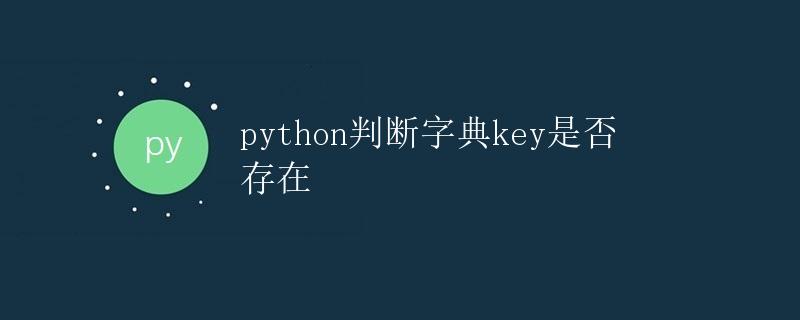Python判断字典key是否存在

在Python中,我们可以使用不同的方法来检查字典中是否存在特定的key。有时候我们需要在访问字典的特定键之前先检查该键是否存在,以避免出现KeyError异常。本文将详细介绍在Python中如何判断字典中是否存在某个key。
方法一:使用in关键字
Python中,我们可以使用in关键字来检查一个key是否存在于字典中。下面是使用in关键字判断字典key是否存在的示例代码:
# 创建一个示例字典
my_dict = {'name': 'Alice', 'age': 25, 'city': 'New York'}
# 使用in关键字判断字典中是否存在特定的key
if 'name' in my_dict:
print("Key 'name' exists in the dictionary")
else:
print("Key 'name' does not exist in the dictionary")
if 'gender' in my_dict:
print("Key 'gender' exists in the dictionary")
else:
print("Key 'gender' does not exist in the dictionary")
在上面的示例代码中,我们首先创建了一个示例字典my_dict,然后使用in关键字检查了字典中是否存在'name'和'gender'两个key。运行上面的代码,将会输出以下结果:
Key 'name' exists in the dictionary
Key 'gender' does not exist in the dictionary
方法二:使用dict.get()
除了使用in关键字外,我们还可以使用字典的get()方法来判断key是否存在于字典中。get(key)方法会在key存在时返回对应的value,如果key不存在,则返回默认值(默认为None)。下面是使用get()方法判断字典key是否存在的示例代码:
# 创建一个示例字典
my_dict = {'name': 'Alice', 'age': 25, 'city': 'New York'}
# 使用get()方法判断字典中是否存在特定的key
name_value = my_dict.get('name')
gender_value = my_dict.get('gender')
if name_value is not None:
print("Key 'name' exists in the dictionary")
else:
print("Key 'name' does not exist in the dictionary")
if gender_value is not None:
print("Key 'gender' exists in the dictionary")
else:
print("Key 'gender' does not exist in the dictionary")
在上面的示例代码中,我们通过get()方法获取了'name'和'gender'对应的value,并根据返回值是否为None来判断key是否存在于字典中。运行上面的代码,将会输出以下结果:
Key 'name' exists in the dictionary
Key 'gender' does not exist in the dictionary
方法三:使用try-except语句
另一种常用的方法是使用try-except语句来捕获KeyError异常。通过尝试访问字典中指定key的value,如果key不存在,会抛出KeyError异常,我们可以利用这一点来判断key是否存在于字典中。下面是使用try-except语句判断字典key是否存在的示例代码:
# 创建一个示例字典
my_dict = {'name': 'Alice', 'age': 25, 'city': 'New York'}
# 使用try-except语句判断字典中是否存在特定的key
try:
name_value = my_dict['name']
print("Key 'name' exists in the dictionary")
except KeyError:
print("Key 'name' does not exist in the dictionary")
try:
gender_value = my_dict['gender']
print("Key 'gender' exists in the dictionary")
except KeyError:
print("Key 'gender' does not exist in the dictionary")
在上面的示例代码中,我们尝试访问了'name'和'gender'两个key,通过捕获KeyError异常来判断key是否存在。运行上面的代码,将会输出以下结果:
Key 'name' exists in the dictionary
Key 'gender' does not exist in the dictionary
方法四:使用collections.defaultdict
collections模块中的defaultdict类是Python中一个特殊的字典类型,它可以在创建时指定默认值类型,当访问字典中不存在的key时,会返回默认值。通过使用defaultdict,我们可以简化字典中key的存在性判断。下面是使用defaultdict判断字典key是否存在的示例代码:
from collections import defaultdict
# 创建一个示例字典
my_dict = {'name': 'Alice', 'age': 25, 'city': 'New York'}
# 将字典转换为defaultdict
my_defaultdict = defaultdict(int, my_dict)
# 判断字典中是否存在特定的key
if my_defaultdict['name']:
print("Key 'name' exists in the dictionary")
else:
print("Key 'name' does not exist in the dictionary")
if my_defaultdict['gender']:
print("Key 'gender' exists in the dictionary")
else:
print("Key 'gender' does not exist in the dictionary")
在上面的示例代码中,我们首先将普通字典my_dict转换为了defaultdict类型my_defaultdict,并通过访问字典获取key的方式来判断key是否存在。运行上面的代码,将会输出以下结果:
Key 'name' exists in the dictionary
Key 'gender' does not exist in the dictionary
小结
本文介绍了Python中四种常用的方法来判断字典中是否存在特定的key,包括使用in关键字、dict.get()方法、try-except语句和collections.defaultdict。根据实际需求和习惯,我们可以选择适合自己的方法来判断字典中的key是否存在,从而避免出现KeyError异常。
 极客笔记
极客笔记